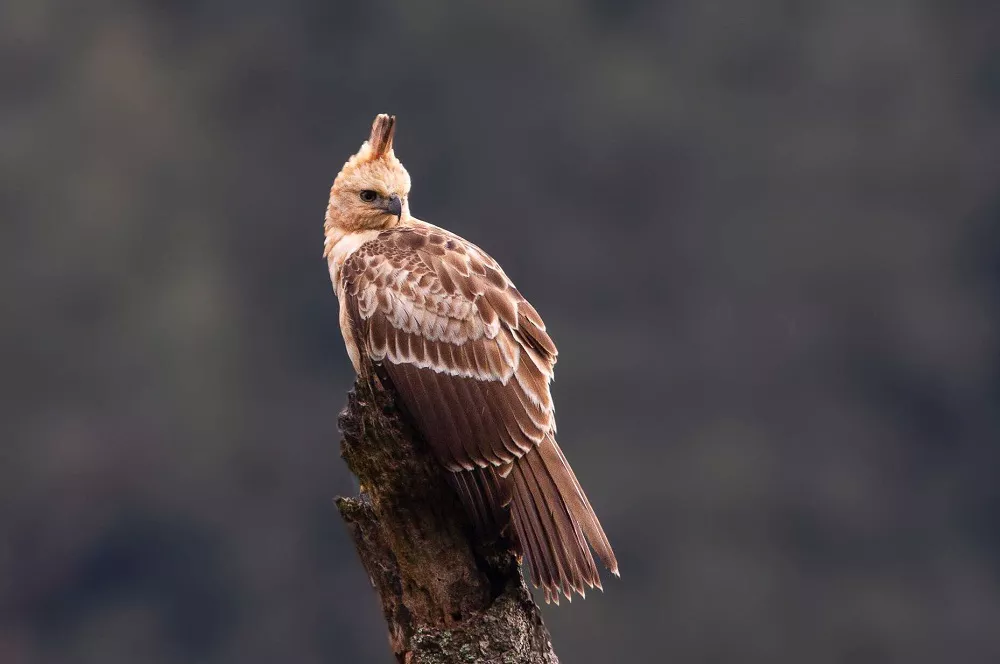The Javan hawk-eagle (Nisaetus bartelsi) is a medium-sized, dark brown raptor in the family Accipitridae. It is the national bird of Indonesia, where it is commonly referred to as Garuda, from the bird-like creatures in Hindu and Buddhist mythology. The scientific name commemorates the Bartels family, who discovered it.
What does Javan hawk-eagle look like
The Javan hawk-eagle is approximately 60 cm (24 in) long. A typical representative of the Asiatic hawk-eagle. They are a medium-sized raptor with a morphology close to that of a Changeable hawk-eagle. Male and female birds are very similar. The black feathers on the top of the head rise to form a long black crest with a white tip. Head and neck are reddish brown. The upper body of the adult bird is dark brown, the lower body is white, the chest has more or less reddish-brown stripes, and the abdomen, flanks and tail coverts have the same color stripes. The flight profile is typical of the genus, with short, broad, rounded wings and a long tail, with feathers, flight feathers, and wing horns conspicuously streaked with black. On landing, the throat is marked with a clear midline. The beak is powerful, the eyes are clear, and the tarsus is densely covered with scaly spots.
The feather color of the chicks is relatively monotonous and dull, and the underparts are more or less reddish-brown but without markings.
Javan hawk-eagle habitat
The Javan hawk-eagles mainly inhabit primary forests. However, due to severe degradation of plain forests, their habitat is limited to steep slopes or rugged ridges and hills. Occasionally, they can be found on recovering moist plots, and may even be found near tea plantations. These medium-sized raptors usually live between 500-1000 meters above sea level. In southeastern Java, they sometimes descend to sea level. It rises to 3,000 meters in the southwest.
Javan hawk-eagle living habit
Each pair of Javan hawk-eagles occupies a territory of about 400 hectares. Lives alone or in pairs, and forms a family flock of three when young are present. Active at dawn or early morning, practice simple, regular loops in the air.
Predominantly hunts in ambush from perches in the forest canopy. Catch prey on the ground or in trees. Adults are resident, while juveniles and chicks roam established habitats.
What does Javan hawk-eagle eat
Javan hawk-eagles hunt mammals and small birds suitable for their food size, including Sunda stink badgers, fruit bats, squirrels, mice, and monkeys, among others. The largest mammal is the Java mouse-deer. Birds include jungle fowl, especially the Green Junglefowl, which belongs to the pheasant family and lives in Java. It also eats partridges, pigeons, nighthawks, woodpeckers and pulsatillas; in addition to lizards, they also catch snakes.
Distribution area of Javan hawk-eagle
Distributed only in Java, Indonesia, there are also some records in neighboring Bali.
Mode of reproduction
The nesting season is from May to August. The bird’s nest is a structure built with small wooden sticks on a tall forest tree 15-50 meters above the ground, reinforced with green leaves. The width and length of the nest is 70 cm x 150 cm, and the depth is about 40 cm. One egg is laid per clutch, and the incubation period lasts 47-48 days, mainly by females. Young eagle eagles stay in the family living area for 1 year or more. The spousal bond was very strong and lasted for several years. The nest sometimes remains for 7-8 years.


 Facebook
Facebook  Instagram
Instagram  Youtube
Youtube 